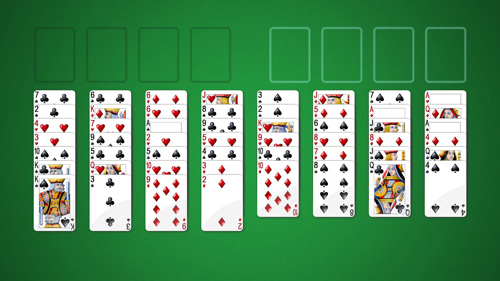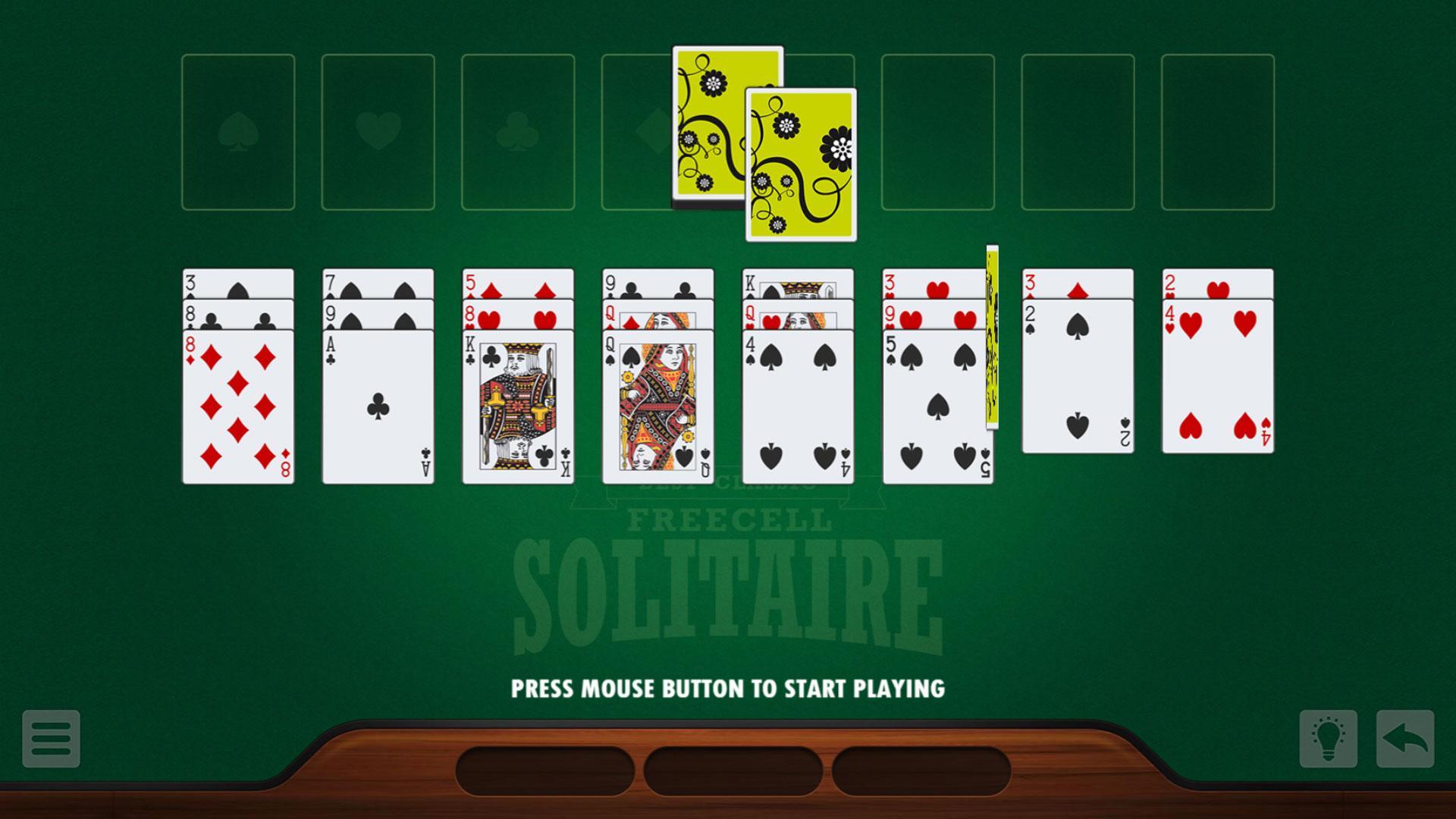Freecell Set up. All 52 cards are dealt into 8 columns, facing up. The last card in each column is highlighted to show it is in play. These cards make up the tableau. Four 'free cells' are located at the top left of the screen to hold cards. Four foundations are at the top right of the screen where you will lay cards Ace to King by suit. In this popular version of the classic card game Freecell Classic, your task is to move all 52 cards to the four piles. Try to go through nine levels in this exciting game. Your task is to lay out cards in the descending order. Play strategically and use four free cells wisely. Classic Freecell. So this version of Freecell strictly follows the rules for playing freecell as found in Hoyle and most of the other solitaire books I've read. You can only move one of the cards between the piles and the freecells at a time. Here's a quick summary of the rules if you're unfamiliar. FreeCell The Classic is a version of one of the most popular card games FreeCell.
- Freecell Classic Offline
- Free Classic Freecell No Download
- Freecell Classic Download
- Freecell Classic Card Game
Introduction to Freecell

Classic FreeCell is played with one 52-card deck of standard playing cards. It's a modification of the solitaire game called Baker's Game. The only real difference is that in FreeCell, they are built by alternate (red and black) colors, while in Baker's Game cards are built by suit.
Almost all FreeCell games are winnable. A rare example of a deal that is considered to be unsolvable is deal number 11982 from Windows 95's version of FreeCell. You can play this deal from the top menu (choose 'Numbered Deals').
Both ranks and suits of cards are important in FreeCell. From low to high, card ranks run in order from Ace, to Two, to Three, and so on up to Ten, Jack, Queen, and finally King.
History
Paul Alfille is credited with the invention of FreeCell. Working at the University of Illinois, he programmed the first computerized version of the game in 1978. Originally, the game had several different variants. The most popular version played today is the Classic version.
Goal
Freecell Classic Offline

The goal of FreeCell is to build up all 4 of the suits in the foundation, each in order from Ace to King.
How to Play Freecell
When the game starts, all 52 cards are dealt face-up into the 8 columns in the tableau. In the first 4 columns, piles of 7 cards are dealt, and in the remaining 4 columns, piles of 6 cards are dealt.

A card may be moved by the player back and forth between the tableau and the free cell area. Any single card may be moved to an empty free cell.

When moving a card from a free cell to the tableau, it can only be placed either into a vacant column or onto the lowermost card in a pile that is next-in-rank and of the opposite (red or black) color. For example, the Four of Spades might be moved from a free cell onto either the Five of Hearts or the Five of Diamonds at the bottom of a pile. Note that since the King possesses the highest rank, it cannot be moved from a free cell onto a pile.
Free Classic Freecell No Download
A card may also be moved either from a free cell or the bottom of a pile to the foundation, providing that it is an Ace, which begins a suit build, or the next in rank for a suit, which extends a build. It's also possible to move a card from the foundation to a free cell or the tableau.

Classic FreeCell is played with one 52-card deck of standard playing cards. It's a modification of the solitaire game called Baker's Game. The only real difference is that in FreeCell, they are built by alternate (red and black) colors, while in Baker's Game cards are built by suit.
Almost all FreeCell games are winnable. A rare example of a deal that is considered to be unsolvable is deal number 11982 from Windows 95's version of FreeCell. You can play this deal from the top menu (choose 'Numbered Deals').
Both ranks and suits of cards are important in FreeCell. From low to high, card ranks run in order from Ace, to Two, to Three, and so on up to Ten, Jack, Queen, and finally King.
History
Paul Alfille is credited with the invention of FreeCell. Working at the University of Illinois, he programmed the first computerized version of the game in 1978. Originally, the game had several different variants. The most popular version played today is the Classic version.
Goal
Freecell Classic Offline
The goal of FreeCell is to build up all 4 of the suits in the foundation, each in order from Ace to King.
How to Play Freecell
When the game starts, all 52 cards are dealt face-up into the 8 columns in the tableau. In the first 4 columns, piles of 7 cards are dealt, and in the remaining 4 columns, piles of 6 cards are dealt.
A card may be moved by the player back and forth between the tableau and the free cell area. Any single card may be moved to an empty free cell.
When moving a card from a free cell to the tableau, it can only be placed either into a vacant column or onto the lowermost card in a pile that is next-in-rank and of the opposite (red or black) color. For example, the Four of Spades might be moved from a free cell onto either the Five of Hearts or the Five of Diamonds at the bottom of a pile. Note that since the King possesses the highest rank, it cannot be moved from a free cell onto a pile.
Free Classic Freecell No Download
A card may also be moved either from a free cell or the bottom of a pile to the foundation, providing that it is an Ace, which begins a suit build, or the next in rank for a suit, which extends a build. It's also possible to move a card from the foundation to a free cell or the tableau.
Freecell Classic Download
An ordered sequence consists of consecutive cards in a pile that are both in-rank and with alternating colors, with the lowest rank being at the bottom. For example, from the bottom up, the Two of Diamonds, the Three of Clubs, and the Four of Hearts constitutes a 3-card ordered sequence.
Freecell Classic Card Game
The player moves one card at a time. However, provided that a sufficient number of combined free cells and tableau columns are empty, an ordered sequence of more than 1 card may be moved all at once from one pile either onto another pile or into an empty column. This counts as only 1 move.

